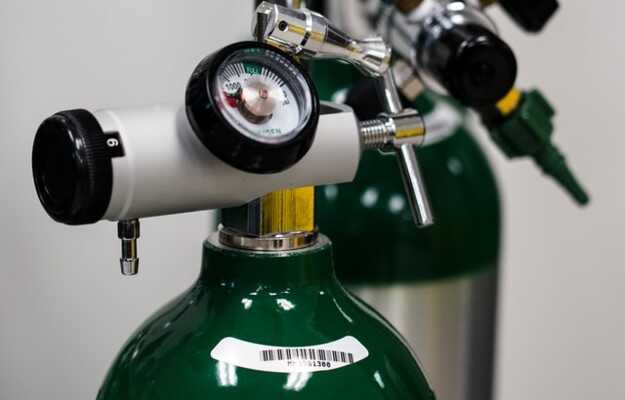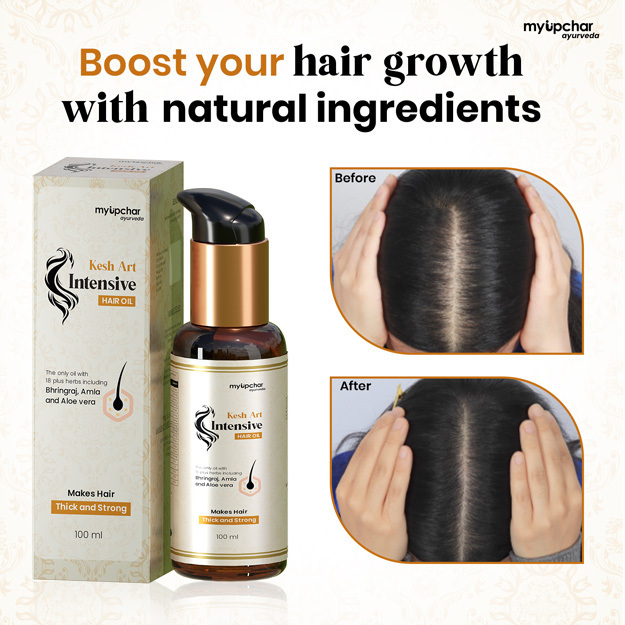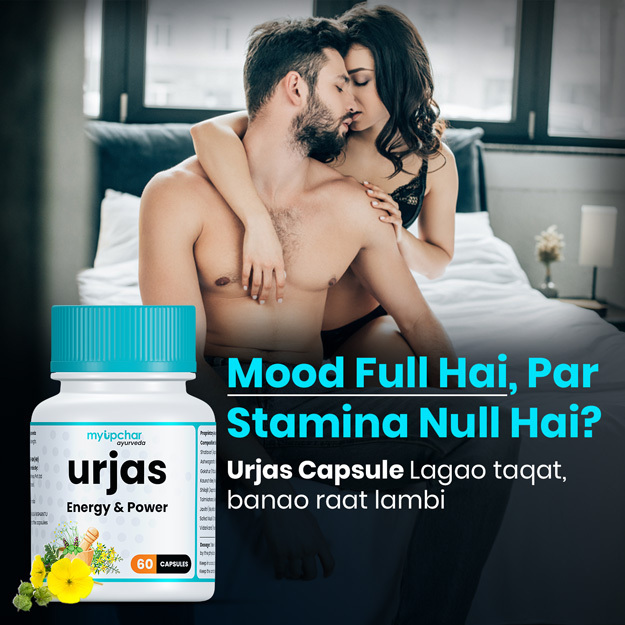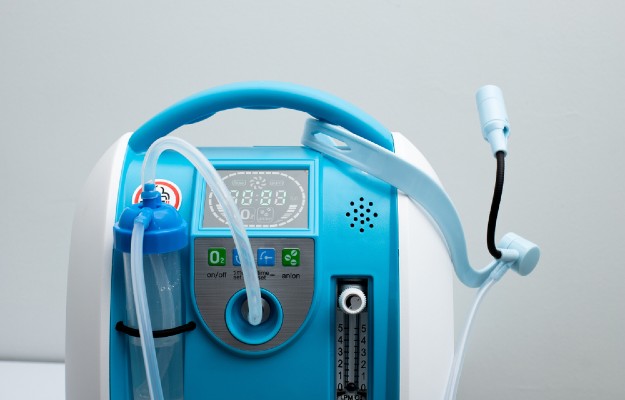Oxygen therapy is essential for providing life-saving care to patients. Patients suffering from COPD (chronic obstructive pulmonary disease), asthma, pneumonia and cystic fibrosis are some of the people who may need oxygen therapy. One of the ways to provide oxygen therapy is through oxygen cylinders. Oxygen cylinders are tanks that contain compressed oxygen in them. They are not only used for medical purposes, but also for other industrial purposes like the mining of steel or activities like mountaineering and diving. Oxygen cylinders can be harmful and lead to injury if not handled in the proper manner. A trolley or backpack may be needed to help easily transport the cylinder if the capacity is on the higher side. They need to be stored away from heat as that can cause a fluctuation in pressure. Since they can be highly flammable, there should be kept safe in environments without any ignition source.
(Read more: Hypoxia)
- Types of oxygen cylinders
- How does an oxygen cylinder work
- Handling oxygen cylinders
- Advantages of using oxygen cylinders
- Disadvantages of using oxygen cylinders
- Oxygen cylinders for COVID-19 patients
Types of oxygen cylinders
Oxygen cylinders can come in many different sizes, from 2.5x5.3 inches to 9x52 inches. The size of the cylinder would determine if it’s portable or fixed (as the weight increase with size) as well as how much oxygen it can contain, which can be anywhere between 42 to 7,000 liters (at 2,200 psi).
(Read more: Respiratory failure)
How does an oxygen cylinder work
An oxygen cylinder is full of compressed gas that is being stored under high pressure. A regulator needs to be attached to the top of the cylinder to work as a tap of sorts; it lets you adjust the flow rate of the oxygen supply, which should be set to what is recommended by your doctor. Another part of the cylinder is the barometer or pressure gauge; this lets you know how much more oxygen is remaining in the cylinder. The valve on top of the cylinder will need to be turned using a wrench before you can begin using it. You can attach the oxygen tube (cannula or mask) to the outlet on the regulator now. Adjust the flow and place the cannula in your nostrils or mask on your face to begin use. The valve should be closed once you’re done using the cylinder. Depending on the type of cylinder, the specifics may differ.
(Read more: Hypoxemia)
Handling oxygen cylinders
Oxygen cylinders should be handled delicately and properly. Following are a few dos and don’ts to follow when dealing with them:
- Do store the oxygen cylinder in a well-ventilated room as some leakage is possible.
- Don’t empty the cylinder completed as that allows air to enter and slowly degrade the pressure vessel from the inside.
- Do keep the cylinder away from direct sun or other heat sources.
- Don’t use oil or grease on or around the cylinder as they can react with the oxygen. This includes any oil or petroleum based products on your face while using the oxygen cylinder.
- Do be gentle when placing cylinders down as a shock can trigger it to blast.
- Don’t lift the cylinder from the neck; instead, use a trolley for any movement.
- Do use it as your doctor has recommended and not otherwise.
- Don’t store extra cylinders upright; instead, lay them on their side and make sure they do not roll.
Advantages of using oxygen cylinders
Oxygen is a basic need for humans to live and survive. An oxygen cylinder fulfils that need when our body is not capable of doing it. Compared to other sources of oxygen, the following are a few advantages of using oxygen cylinders:
- There is no warm-up time required for the cylinder to provide oxygen therapy to the patient, unline in concentrators.
- They do not require any power source, which makes them ideal for areas with unpredictable electricity supply.
- They are cheaper than concentrators - if the oxygen needs are only temporary and not long-term.
- There is minimal maintenance required with oxygen cylinders.
Disadvantages of using oxygen cylinders
Given a choice between different sources of oxygen supply, the following are a few disadvantages of using oxygen cylinders that you may want to keep in mind:
- They do not provide an unlimited supply of oxygen, unlike oxygen concentrators.
- They are heavy, which makes them difficult to transport every time they need to be refilled.
- They need to be handled with the utmost care to avoid an accident.
- They turn out to be more expensive than some other oxygen sources when needed for long term use.
(Read more: Pneumonia and COVID-19)
Oxygen cylinders for COVID-19 patients
The normal range for oxygen in healthy individuals is between 95 and 100%. These levels may fall due to many reasons, one of them being a COVID-19 patient. Since the beginning of the COVID-19 pandemic, it has been noted that low levels of oxygen saturation in blood and muscles at the time of admission is directly linked to the risk of a bad outcome. Oxygen levels can drop drastically in COVID-19 patients and often there may be no symptoms of it.
A pulse oximeter should be used to monitor O2 levels of all coronavirus patients. As soon as the levels drop below 95%, you should contact your doctor for the next step. If your levels suddenly drop below 90%, you should seek emergency medical care as your condition could be critical. When the levels drop low, oxygen therapy may be recommended by your doctor. If you’re getting care at home, you could use an oxygen cylinder for this purpose. Cylinders could also be used in combination with oxygen concentrators in COVID-19 cases.
It is important to remember that oxygen therapy should be used as per the direction of your doctor. Ask them or an experienced technician to explain how to properly set up, use and store an oxygen cylinder.
(Read more: Complications of severe COVID-19)
Doctors for Oxygen cylinders

Dr. Rajesh Kumar
Internal Medicine
1 Years of Experience

Dr. Shubham Satsangi
Internal Medicine
7 Years of Experience

Dr Rahul
Internal Medicine
4 Years of Experience

Dr. C. Rajendran
Internal Medicine
19 Years of Experience
Medicines / Products that contain Oxygen cylinders
- Proctosedyl BD Cream - ₹108
- Anovate Cream - ₹140
- Pilo GO Cream - ₹80
- Covifor Injection - ₹3780
- Fabiflu 200 Mg Tablet - ₹1292
- Fabiflu 400 Tablet - ₹856
- Fabiflu (Favipiravir) 400 Mg Tablet - ₹1224
- Fabiflu (Favipiravir) 200 Mg Tablet - ₹1292
- Remdesivir Injection - ₹10500
- Molusafe Capsule - ₹457
- Movfor 200 Mg Capsule - ₹2490
- Molflu 200 Mg Capsule - ₹1400
- Molulife 200 Capsule - ₹1399
- Cipmolnu 200 Mg Capsule - ₹2000
- Molxvir 200 Mg Capsule - ₹1520
- Immunocin Alpha Plus 1.6mg Injection - ₹5998
- Alzumab Injection - ₹8229
- Imualfa 1.6mg Injection 1ml - ₹2628
- Molnutor 200 Mg Capsule - ₹2000
- Sotrovimab Injection - ₹165000
- Nirmatrelvir - ₹5000
- Molnupiravir 200 Mg Capsule - ₹1400
- Covihalt 200 Tablet - ₹465
- Ciplenza Tablet - ₹646
- Itolizumab Injection - ₹8220


















